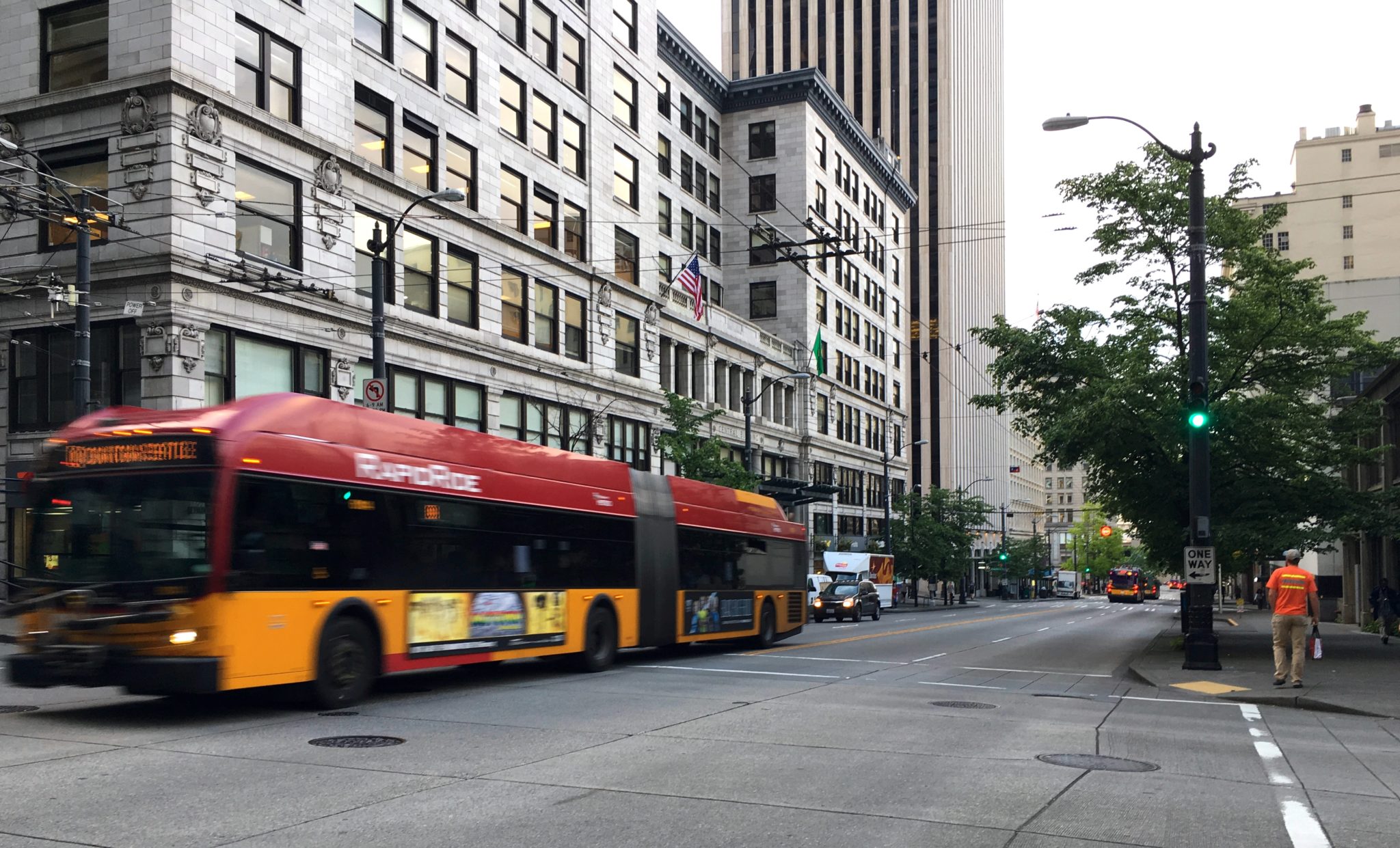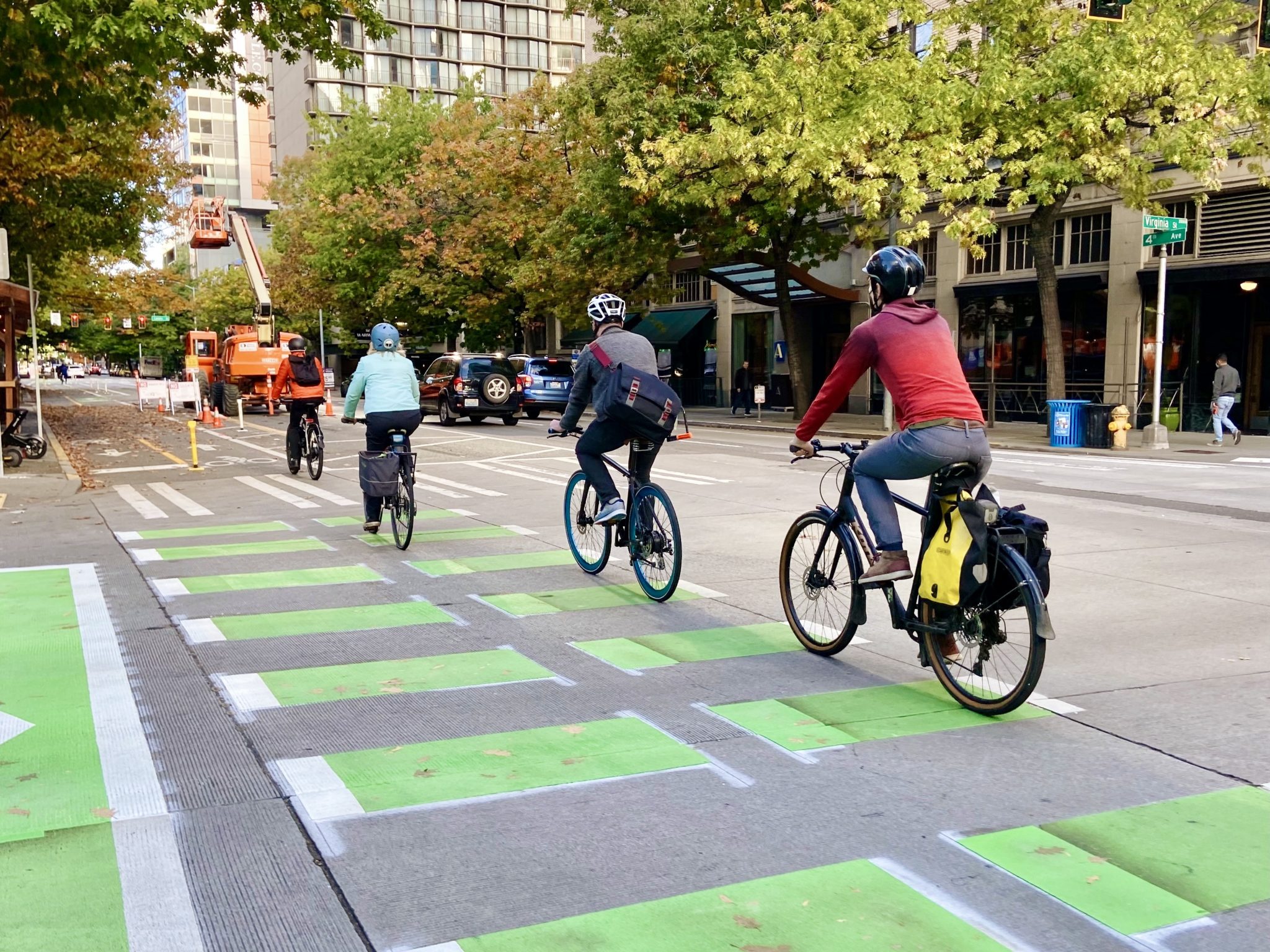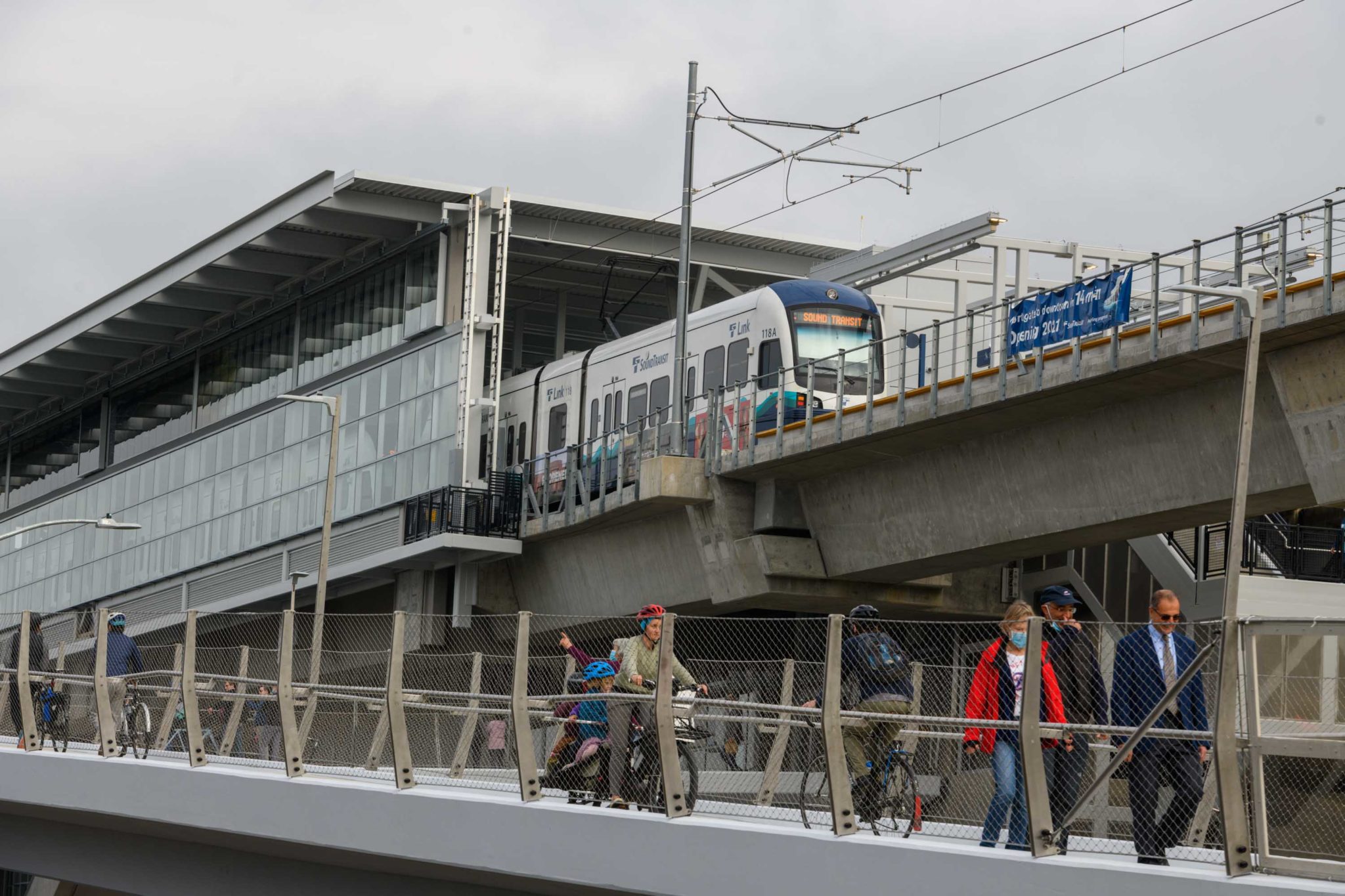 View of downtown Seattle at sunset, looking north. Elliott Bay is visible to the left, Lake Union in the center, and Interstate 5 to the right. Photo: SDOT
View of downtown Seattle at sunset, looking north. Elliott Bay is visible to the left, Lake Union in the center, and Interstate 5 to the right. Photo: SDOT Summary:
- The Seattle 2030 District recently announced the Seattle Department of Transportation (SDOT) as the winner of its 2022 Vision Award in transportation.
- You can check out this 2-minute video highlighting the award, which features an interview with Seattle Chief Equity Officer and Deputy Mayor Adiam Emery.
- Seattle 2030 District’s public and private sector members are committed to significantly reducing water and energy use, stormwater pollution, and carbon emissions from transportation by the year 2030.
- We appreciate this award and recognition of the important work our team here at SDOT is doing every day to advance sustainable transportation solutions in Seattle and beyond.
- From supporting more transit options, to building new protected facilities for people of all ages and abilities to safely bike, walk, and roll through the city, to advancing vehicle electrification, and more, we are working hard every day to boldly address the real, imminent challenge of climate change.
- Our sustainable transportation goals are an important part of the City of Seattle’s overall climate goals detailed in the 2013 Seattle Climate Action Plan and 2018 Seattle climate strategy update.
Check out this 2-minute video highlighting the 2022 Vision Award in Transportation that we recently received from Seattle 2030 District, including a brief interview with Seattle Chief Equity Officer and Deputy Mayor Adiam Emery.
The video is embedded below – so you can just hit play!
Scientists across the globe agree that climate change is real – and that it represents a major crisis for our shared future that demands a robust response at all levels.
As a result, Seattle has established a series of necessarily ambitious goals to combat greenhouse gas emissions that are contributing to climate change. We are working towards a goal of reducing greenhouse gas emissions 58 percent by 2030 and becoming carbon neutral by 2050. Part of achieving that means reducing transportation emissions 82 percent from 2008 levels by 2030. Transportation emissions currently make up over 60 percent of the City’s total greenhouse gas emissions.
We have connected these citywide climate and carbon emissions goals to key transportation metrics. Specifically, we aim to have 90% of all personal trips, 100% of all shared mobility trips, and 30% of all freight trips be zero-emissions by 2030.
Zero-emissions trips could be made by travel modes such as walking, rolling, biking, and taking transit, as well as using Electric Vehicles (EVs). In addition, trips that are avoided entirely (e.g., remote work) can be considered an important element in reducing our overall citywide emissions.

Working together to realize our shared vision of a sustainable future
Our sustainability and climate goals align with – and contribute directly to – achieving the goals established by the Seattle 2030 District.
When we make it easier for people to access buildings in carbon-friendly ways, it’s a win-win for Seattle workers, businesses, and community members in general – and for reaching both the City’s and the Seattle 2030 District’s sustainability targets. Part of a building’s overall environmental impact is how people travel to and from it. We work to ensure that people have choices in how they travel. Through our Transportation Options and Transportation Management programs, we work closely with property managers and businesses to support and promote those choices.
We applaud the Seattle 2030 District for thinking holistically and bringing people together to comprehensively tackle a challenge of this scale, which requires more collective effort than just any one individual person, group, or building.
We also recognize the importance of creating high-quality transportation programming and partnerships through the private and public sectors, and within the City of Seattle and its departments, so this collaboration fits hand in hand with our One Seattle approach to work together and strengthen connections to reach the best outcomes.

Our projects are helping make more sustainable, climate-friendly trips possible.
Here are a few examples of how we are investing in safer, more sustainable transportation infrastructure throughout Seattle to support more walking, biking, and transit trips:
- We continue to install Leading Pedestrian Intervals (LPIs) allow pedestrians a head start to cross the street at sidewalks and intersections throughout the city, and other signal upgrades.
- In 2021 alone, we installed more than 1,500 curb ramps – exceeding our annual target of 1,250, to meet current accessibility standards and improve safe access for all people.
- We’ve completed our Center City Bike Network and continue to add more protected bike lanes and neighborhood greenways around Seattle toward a connected citywide network.
- We’re installing transit infrastructure enhancements, including new transit lanes, spot improvements, building out King County Metro’s RapidRide bus rapid transit system, and increasing access to light rail stations.

We also invest in transportation programs that help make progress towards greater sustainability.
These programs include: (but are not limited to)
- Electrifying the freight sector: We are piloting zero-emissions goods delivery with cargo bikes and delivery hubs.
- Transportation Demand Management programs: Our nationally-recognized Transportation Demand Management programs help support a shift from personal vehicles to more sustainable and efficient travel options
- Increasing access to transit: We are providing free or reduced-cost ORCA cards and transit rider training to middle, high school, and college students, as well as Seattle Housing Authority residents and limited-income individuals.

Elevating equity in all of our work – including sustainable transportation
Regarding sustainability, we believe that Climate Justice is an important part of Racial Justice, and aligns with our overall departmental values and goals, which include Equity and Sustainability. As such, delivering a transportation system that is truly equitable means that carbon emissions reduction is an important aspect of working to deliver on our mission. We are bringing this equity lens to the way we approach meeting our emissions challenge, and will continue to improve upon it as we hone and refine our response to the major shared challenge of climate change.
For several years, we have been working closely with a group of community members on a Transportation Equity Workgroup to develop a Transportation Equity Framework and implementation plan. The workgroup’s efforts, as well as our public engagement and community conversations all across the city, have been essential to moving this work forward.
We look forward to continuing this important work to advance sustainable transportation options, and partnering with many organizations across the public, private, and non-profit sectors, and in communities throughout the city, to achieve our goals for a sustainable future together, as One Seattle.